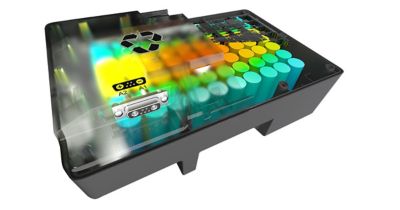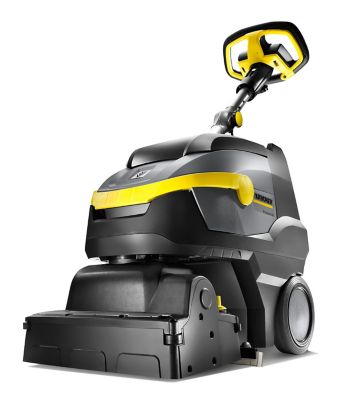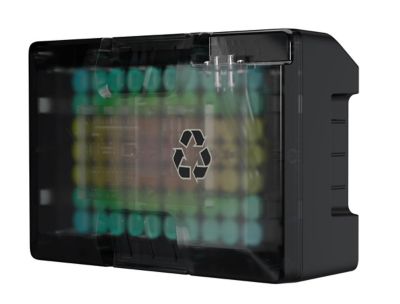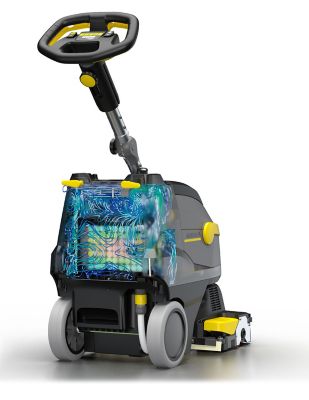ANSYS ADVANTAGE MAGAZINE
May 2021
Kärcher Cleans Up with Ansys Twin Builder
By Ansys Advantage Staff
The journey from creative thinking to product realization is paved with good intentions. Many possibilities that look promising at the outset never make it to market. Simulation in both the ideation and iteration stages of product design and development makes getting to “what’s next” take less time, effort and expense. When used holistically, simulation enables companies to efficiently bring innovative, well-engineered products to consumers.
By simulating the electrochemical-thermal flow of different battery cells under what would be real-life consumer conditions, Kärcher identified a cell type and a battery housing design that would allow them to reduce the number of cells in the battery pack by 20%.
Kärcher, a German manufacturer of high-pressure cleaning and other equipment, is known worldwide for innovation. Their pioneering products include the first modern pressure washer, first window vacuum cleaner and first fully autonomous vacuum robot. At Kärcher, simulation helps facilitate product realization — that is, the end-to-end process that ensures a product will meet performance and quality objectives. Whether they’re developing a new product or enhancing existing equipment, simulation enables product teams to stay on track while generating, selecting, implementing and validating better, more viable ideas in the early development phase.
Being able to virtually compare concepts and understand trade-offs is an essential part of that process. That includes understanding how changes to one component affect not just other components but the system as a whole. But this is something that is often impossible to determine with conventional finite element analysis (FEA) or computational fluid dynamics (CFD) software alone, at least without considerable computational time or cost.
To overcome that barrier, Kärcher engineers used Ansys Twin Builder as the basis for a digital engineering workflow that enabled fast and accurate concept comparisons during optimization of a new device and two existing products: a vacuum cleaner and a battery-powered floor cleaner.
Twin Builder is a digital twin platform that combines the power of a multi-domain systems modeler with extensive 0D application-specific libraries, 3D physics solvers and reduced-order model (ROM) capabilities. Ansys Twin Builder enhances the possibilities of digital engineering by making simulation of whole devices feasible. By combining its Modelica capabilities with Ansys Fluent, the Kärcher design team gained a previously unattainable holistic view of an entire product, reduced computation time from days to minutes, and avoided expensive physical prototyping.
By combining Ansys Twin Builder’s Modelica capabilities with Ansys Fluent, the Kärcher design team gained a previously unattainable holistic view of an entire product, in this case, an electric floor cleaner.
Insight into the Entire System, in Minutes, Not Days
On the surface, electric cleaning devices may seem simple and the tasks they tackle mundane — mop a grimy floor or vacuum up spilled cereal — but in reality they’re extremely sophisticated products. The fluid pumps alone have multiple parts, including a crankshaft, inlet and outlet valves, plungers, regulators, and safety devices. Add in the other components — air pumps, electronic terminals and controls, heat exchangers, mechanical parts such as switches, and, often, high-density battery packs — and it’s easy to see how complex the design process can be, as well as how the right decisions on the front end can lead to better engineering outcomes and greater consumer satisfaction down the road.
Even optimizing the performance of existing devices is a strenuous process that can go far beyond a tweak here and an adjustment there — especially as new technology becomes available and consumer preferences change. Engineers have to know how existing products work, and not just in the sense of turning a knob to see what happens. Instead, they have to understand the interaction between parts as well as how changing one component can necessitate changing others. Without this information, they may relaunch a product only to discover that nothing has improved.
Simulation resulted in a lighter and more compact battery pack design, lowering material requirements and costs.
Before Kärcher began using Twin Builder, they simulated each component individually with classic FEA or CFD software. While that helped engineers understand how a part behaved under varying conditions, it didn’t provide insight into the system as a whole. Modeling the entire device with individual software was possible but time-consuming — computation could take as long as three days, creating undesirable delays for engineers trying to compare early design phase concepts. Yet if they overlooked this step and didn’t simulate the whole device, Kärcher risked getting a product nearly to market before uncovering potential problems that could send engineers back to the virtual drawing board.
Combining the multidisciplinary features of Twin Builder with Fluent provided the proof-of-concept checks Kärcher required. In the case of the vacuum cleaner optimization project, adding Twin Builder to the mix cut computation time from days to minutes. Result accuracy was within 5% to 6% of FEA or CFD alone, a suitable margin during ideation.
Simulating a Smaller Battery Pack to Reduce Weight and Heat
Among Kärcher’s product optimization priorities was the development of a new battery pack for a well-established floor cleaner. Kärcher is increasing their presence in consumer markets, and to satisfy the preference for lighter, more flexible products, engineers wanted to downsize the 70-cell battery pack. As part of that mission, they sought to incorporate a new type of battery cell that would produce as much power as the existing pack but with fewer cells.
To enable accuracy and speed, engineers modeled the rechargeable battery pack in Twin Builder and the entire cleaning device in Fluent. Coupling the two enabled engineers to extract key battery pack characteristics from Twin Builder and to increase computational efficiency. In fact, simulating the battery pack in Twin Builder took less than two minutes; simulation of the entire cleaning device simulation was completed in four hours.
Floor cleaner with battery pack simulation
Contending with heat buildup is always an issue in battery pack design. Heat stresses batteries, leads to longer loading times and increases the risk of failure, which is particularly unacceptable in consumer products where long battery life equals customer satisfaction.
By simulating the electrochemical-thermal flow of different battery cells under what would be real-life consumer conditions, Kärcher identified a cell type and a battery housing design that would allow them to reduce the number of cells in the battery pack by 20%. Not only did this cut heat generation, it also resulted in lighter and more compact designs and lowered material requirements and costs.
Replicating Real-Life Operating Conditions
In the end, Kärcher simulated the entire battery pack using Twin Builder and Modelica, which enables component-oriented modeling of complex systems. Engineers also applied Fluent to simulate the airflow inside the entire cleaning device. The two-way coupling of these simulations provided the additional flexibility engineers needed to consider things like different battery cells or battery pack housing materials under real-life installation situations. Because of the computational complexity involved in such detailed system simulations, that would not have been manageable using CFD software alone.
With Twin Builder, Kärcher completed simulations on a system level at a size and scale that was previously infeasible.
讓我們開始吧
如果您面臨工程挑戰,我們的團隊將隨時為您提供協助。憑藉豐富的經驗和對創新的承諾,我們邀請您與我們聯絡。讓我們共同合作,將您的工程障礙轉化為成長和成功的機會。立即與我們聯絡,開始對話。



